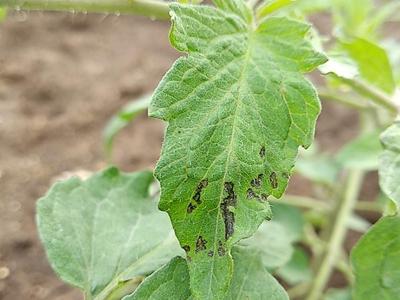Gray Leaf Spot
Stemphylium solani
Fungus
5 mins to read
In a Nutshell
- Lesions with concentric pattern, a whitish center and purple margins on upper leaves.
- Cracking of the leaf tissues and “shot-hole” appearance.
- Tightly linked to potassium deficiency .
Can also be found in
Symptoms
Gray Leaf Spots can be up to about 2 cm in diameter, circular in shape and with purple margins. As they mature, they grow forming a concentric pattern and a whitish center develop within the lesions, which may later crack and fall out, producing a “shot-hole” appearance. The lesions normally form on the upper leaves in the canopy and start at the leaf margin and move inward. Upper leaves on plant in late bloom stage are the most prone to infection, because of the high demand for nutrients at that time. This disease is secondary if detected and treated with K on time. But it can lead to massive premature defoliation and yield loss if left untreated.
Recommendations

Organic Control
To this day, no biological control solution is known against this disease. Follow preventive measure to avoid it.

Chemical Control
Always consider an integrated approach with preventive measures and biological treatments if available. Fungicides are available to treat this disease (pyraclostrobin, pyraclostrobin + metconazole) but are not normally recommended for its control as they are not economically viable.
What caused it?
The symptoms are caused by the fungus Stemphylium solani. Its incidence and the development of the disease is favored by high humidity, frequent rains and also prolonged drought. Physiological or nutritional stresses are also an important element, particularly during flowering or boll formation. Potassium deficiency is the main factor but it may be coupled to drought, insect pressure or the presence of nematodes in the soil. Wind also help in the dispersal of the spores of these fungi to other plants. Temperatures of about 20-30 °C are optimal for the development of the diseases. This fungus may form a disease complex with fungi of the genera Alternaria and Cercospora and may be observed within the same field. Alternative hosts include cotton, tomato, potato, pepper, eggplant and onion.
Preventive Measures
- Test fields for potassium is possible and apply this nutrients as part of the basal fertilization if needed.
- Plant long season varieties with low requirements on potassium.
- Monitor field regularly for signs of the disease.
- Make sure to have vigorous crop with a balanced fertilization.
- Apply fertilizers rich in potassium in a timely manner (split applications), especially on sandy soils.
- Plan foliar applications during the first four weeks of bloom, if required.
- Do not over-fertilize with potassium to solve the problem.
- Irrigate regularly to avoid drought stress.



